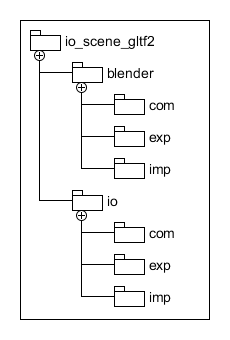| Blender Version | Documentation |
|---|---|
| 2.80 | https://docs.blender.org/manual/en/2.80/addons/io_scene_gltf2.html |
| dev | https://docs.blender.org/manual/en/dev/addons/import_export/io_scene_gltf2.html |
Notes:
- 2.80 is the current stable release
- 2.81 is currently in beta, no new features can be added, only critical bugs. Check blender-v2.81-release branch
- master branch of this addon is mirrored in Blender master, that will become 2.82
Developed by UX3D and Julien Duroure, with support from the Khronos Group, Mozilla, and Airbus Defense & Space.
Official Khronos Group Blender glTF 2.0 importer and exporter.
This project contains all features from the previous exporter, and all future development will happen on this repository. In addition, this repository contains a Blender importer, with common Python code shared between exporter and importer for round-trip workflows. New features are included or under development, but usage and menu functionality remain the same.
The shared codebase is organized into common (Blender-independent) and Blender-specific packages:
This structure allows easier Blender 2.79 to 2.80 updates, and enables common code to be reused by third-party Python packages working with the glTF 2.0 format.
The main importer and exporter interface is the Python glTF scene representation.
Blender scene data is first extracted and converted into this scene description. This glTF scene description is exported to the final JSON glTF file. Any compression of mesh, animation, or texture data happens here.
For import, glTF data is parsed and written into the Python glTF scene description. Any decompression is executed in this step. Using the imported glTF scene tree, the Blender internal scene representation is generated from this information.
The Khronos glTF 2.0 importer and exporter is enabled by default in Blender 2.8 and higher. To reinstall it — for example, when testing recent or upcoming changes — copy the addons/io_scene_gltf2 folder into the scripts/addons/ directory of the Blender installation, then enable it under the Add-ons tab. For additional development documentation, see Debugging.
- Debug with PyCharm NOTE: If you are using Blender 2.80, you need the updated debugger script
- Debug with VSCode
Several companies, individuals, and glTF community members contribute to Blender glTF I/O. Functionality is added and bugs are fixed regularly. Because hobbyists and professionals using Blender glTF I/O rely on its stability for their daily work, continuous integration tests are enabled. After each commit or pull request, the following tests are run:
- Export Blender scene and validate using the glTF validator
- Round trip import-export and comparison of glTF validator results
These quality-assurance checks improve the reliability of Blender glTF I/O.
To run the tests locally, your system should be modified to include blender279b and blender28 as shell scripts (or Windows .bat files) in the path that launch their respective versions of Blender, including all command-line arguments.
The latest version of Yarn should also be installed.
Then, in the tests folder of this repository, run yarn install, followed by yarn run test. You can limit the test suite to one version of Blender with yarn run test-blender279b or yarn run test-blender28.



